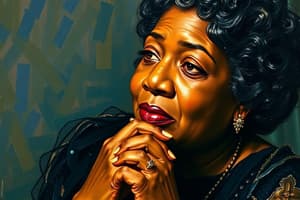Podcast
Questions and Answers
Which of the following is NOT a characteristic of literary elements?
Which of the following is NOT a characteristic of literary elements?
- Theme explanation
- Metrical structure (correct)
- Setting description
- Character development
What distinguishes poetry from prose?
What distinguishes poetry from prose?
- Use of narrative structure
- Measurement of text (correct)
- Complexity of themes
- Presence of dialogue
In narrative structure, which part follows the climax?
In narrative structure, which part follows the climax?
- Exposition
- Falling action (correct)
- Denouement
- Rising action
Which aspect is part of the organizational method of literary structure?
Which aspect is part of the organizational method of literary structure?
What is NOT a form of literary text?
What is NOT a form of literary text?
Which of the following correctly identifies the components of a plot's exposition?
Which of the following correctly identifies the components of a plot's exposition?
Flashcards are hidden until you start studying
Study Notes
Literature Overview
- Literature encompasses letters, which can be either oral or written forms of communication.
Body of Written Works
- Written works include imaginative and creative pieces, particularly poetry and prose.
- Classification of literature is based on various criteria such as language, natural origin, historical context, genre, and subject matter.
Literary Text Characteristics
- Literary texts involve a vast range of written literature that serves to:
- Narrate a story.
- Convey significant messages or information.
- Express a variety of feelings, thoughts, and emotions.
- Literary structure involves both content and form, governing how stories are organized.
- Organizational methods involve the arrangement of purpose, style, and genre within stanzas.
- Identifiable features include genre characteristics, stylistic elements, trends within literature, and the broader definition of art.
Poetry
- Poetry is categorized into two main forms:
- Metrical structures, which emphasize rhythm and meter.
- Dramatic and narrative forms, including lyric poetry.
- Prose differs from poetry by lacking specific measurement, characterized by a normal flow of words.
- Prose includes both fictive works and non-fictive accounts.
Literary Elements
- Key identifiable characteristics of literature include:
- Setting: The environment in which a story takes place.
- Character: The individuals involved in the story.
- Conflict: The central struggle between opposing forces.
- Theme: The underlying message or main idea.
- Point of View (P.O.V.): The perspective from which the story is told.
- Plot structure consists of:
- Exposition: Introduction of background information.
- Rising Action: Development of conflict leading to the climax.
- Climax: The peak of tension in the narrative.
- Falling Action: Events following the climax leading to resolution.
- Denouement: The conclusion or resolution of the story.
Studying That Suits You
Use AI to generate personalized quizzes and flashcards to suit your learning preferences.




